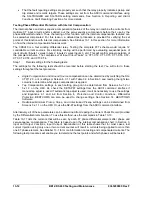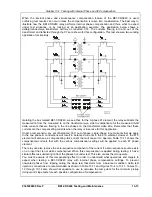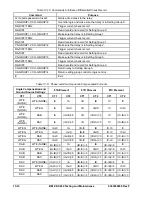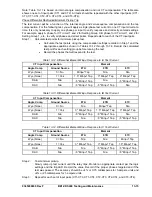
13-26
BE1-CDS240 Testing and Maintenance
9365200990 Rev F
Refer to Section 6,
Reporting and Alarm Functions, Fault Reporting, Fault Summary Reports,
for
information on retrieving fault summary reports.
Sequence of Events Recorder (SER) Function
Reset SER registers and verify that there are no SER events. SER directory reports can be read by
transmitting the ASCII command RS or through the front panel HMI Screen 4.2. To clear (reset) SER
registers, first gain write access to the reporting functions (R password) and then initiate the RS-NEW=0
command.
Purpose:
To verify that all SER registers are cleared before initially loading the system.
Reference Commands:
RS, RS-NEW=0
Refer to Section 6,
Reporting and Alarm Functions, Sequence of Events Recorder Function,
for
information on retrieving and resetting SER records.
System Report Documentation
After completing all previous steps in
Commissioning Testing
and before placing the protection system in
service, it is important to create a record of the relay settings and system status at the time of
commissioning. This report should be kept for comparison in future maintenance procedures.
To create the settings record, transmit the ASCII S command and then use normal personal computer
techniques to save or print the SER report that is returned.
To create the status record, transmit the ASCII RG-STAT command and then use normal personal
computer techniques to save or print the status report that is returned.
Purpose:
To create a permanent status and settings record for future reference before initially loading the
system.
Reference Commands:
S, RG-STAT
Refer to Section 6,
Reporting and Alarm Functions, General Status Reporting,
and
Sequence of Events
Recorder Function,
for information on retrieving and resetting SER records.
In Service Current Circuit Verification
To verify correct CT circuit connections, internal phase, zero-sequence and tap compensation settings for
the differential functions, it is recommended that the load be placed on the protected zone and a
differential check record be triggered, recorded, and examined. See Section 6,
Reporting and Alarm
Functions, Differential Current Monitoring Function,
for more information on differential check records.
To assist you in performing this procedure, an
Annotated Differential Check Record
and an
In Service
Current Circuit Verification Form
is provided on the following pages. It is recommended that this form be
copied, completed (filled out) and that the differential check record retrieved from the relay be captured to
a file and printed. These two documents should then be placed with the commissioning records for future
reference.
Test Scenarios
The protected circuit should be loaded prior to triggering a differential check record. It is desirable that the
loading be great enough to result in relay currents that are above the minimum sensitivity of the
differential current diagnostic function but not great enough to cause a trip if there is a problem in the
installation. The minimum sensitivity of the differential current diagnostic function is 150 milliamperes of
secondary current for 5-ampere relays and 30 milliamperes of secondary current or 1 ampere relays.
When you put initial loading on the differential zone of protection, one of four scenarios may result:
1. Everything
is
correct
and there is
no differential alarm
or
trip.
2. There is a
problem
with the settings or installation but the initial loading is too low so there is
no differential alarm
or
trip.
3. There is a
problem
with the settings or installation and the initial loading is great enough to
cause a
differential alarm
but not a trip.
Summary of Contents for BE1-CDS240
Page 2: ......
Page 8: ...vi BE1 CDS240 Introduction 9365200990 Rev F This page intentionally left blank ...
Page 38: ...1 28 BE1 CDS240 General Information 9365200990 Rev F This page intentionally left blank ...
Page 40: ...ii BE1 CDS240 Quick Start 9365200990 Rev F This page intentionally left blank ...
Page 152: ...ii BE1 CDS240 Metering 9365200990 Rev F This page intentionally left blank ...
Page 226: ...iv BE1 CDS240 Application 9365200990 Rev F This page intentionally left blank ...
Page 286: ...ii BE1 CDS240 Security 9365200990 Rev F This page intentionally left blank ...
Page 290: ...9 4 BE1 CDS240 Security 9365200990 Rev F This page intentionally left blank ...
Page 292: ...ii BE1 CDS240 Human Machine Interface 9365200990 Rev F This page intentionally left blank ...
Page 306: ...10 14 BE1 CDS240 Human Machine Interface 9365200990 Rev F This page intentionally left blank ...
Page 308: ...ii BE1 CDS240 ASCII Command Interface 9365200990 Rev F This page intentionally left blank ...
Page 342: ...11 34 BE1 CDS240 ASCII Command Interface 9365200990 Rev F This page intentionally left blank ...
Page 349: ...Figure 12 5 Horizontal Rack Mount Front View 9365200990 Rev F BE1 CDS240 Installation 12 5 ...
Page 361: ...Figure 12 17 Typical DC Connection Diagrams 9365200990 Rev F BE1 CDS240 Installation 12 17 ...
Page 372: ...12 28 BE1 CDS240 Installation 9365200990 Rev F This page intentionally left blank ...
Page 468: ...13 92 BE1 CDS240 Testing and Maintenance 9365200990 Rev F This page intentionally left blank ...
Page 512: ...14 42 BE1 CDS240 BESTCOMS Software 9365200990 Rev F This page intentionally left blank ...
Page 544: ...ii BE1 CDS240 Terminal Communication 9365200990 Rev F This page intentionally left blank ...
Page 550: ...ii BE1 CDS240 Settings Calculations 9365200990 Rev F This page intentionally left blank ...
Page 578: ...D 28 BE1 CDS240 Settings Calculations 9365200990 Rev F This page intentionally left blank ...
Page 579: ......






































